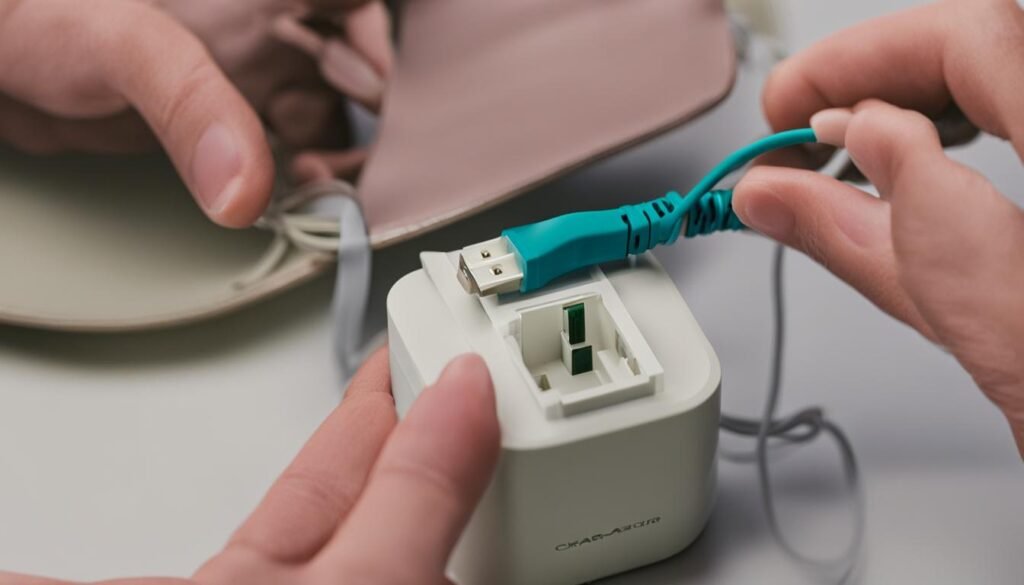Mastering how to Clean Widex Hearing Aids is a critical aspect of their care, crucial for maintaining their performance and extending their lifespan. This comprehensive guide focuses on the best practices for cleaning your Widex hearing aids, offering valuable tips to ensure they remain effective and well-maintained.
Regular cleaning is vital in preventing problems related to debris and moisture buildup. Although Widex hearing aids are designed to be water-resistant, they are not impervious to water damage. Therefore, removing them during water-involved activities like swimming or showering is advisable. Prompt and thorough drying is essential when wet, like sweat or rain.
We’ll walk you through the safe cleaning methods, emphasizing the use of specialized tools to remove earwax and debris, particularly from sensitive areas such as the microphone and receiver tubes. This guide also advises what to avoid, like water or harsh cleaning solutions, and recommends using soft, dry cloths or specific hearing aid cleaning wipes for the surface.
Key Takeaways:
- Widex hearing aids are water-resistant but should be removed during water-related activities.
- Use the provided cleaning tools to remove earwax and debris from your hearing aids.
- Avoid using water or cleaning solutions; opt for a soft, dry cloth or hearing aid cleaning wipe.
- Regular cleaning is crucial to maintain the performance and lifespan of your Widex hearing aids.
How to Change Hearing Aid Filter on Widex Devices
Proper maintenance of your Widex hearing aids includes regular cleaning and replacement of the filters. Filters are crucial in preventing earwax and debris from entering the device and affecting its performance. Follow these steps to change the filter on your Widex hearing aids:
- Remove the old filter: Use the provided tool or a pair of tweezers to carefully remove the old filter from the designated slot on the hearing aid.
- Insert a new filter: Take a new filter and insert it into the slot, making sure it fits securely.
When changing the filter, following the manufacturer’s instructions and guidelines for your specific Widex hearing aid model is essential. This will ensure proper installation and functionality, allowing you to enjoy clear and comfortable sound.
Proper Maintenance Tips for Widex Hearing Aid Filters
Maintaining the filters on your Widex hearing aids is essential for optimal performance. Here are some tips to help you keep your filters clean and functioning effectively:
- Inspect the filters regularly: Check the filters for any signs of blockage or buildup. It may be time to change the filter if you notice excessive earwax or debris.
- Follow the recommended replacement schedule: Refer to the user manual or consult your hearing care professional to determine the frequency of changing the filters. This will vary depending on your individual needs and usage.
- Keep the filters dry: Avoid exposing them to excessive moisture, which can compromise their effectiveness. Remove your hearing aids before showering, swimming, or engaging in activities that may cause them to get wet.
- Gently clean the filters: Use the provided tools or a soft brush to remove any visible debris from the filters. Avoid using water or cleaning solutions, as they can damage the filters.
By incorporating these maintenance practices into your routine, you can ensure that your Widex hearing aids continue to provide optimal performance and meet your hearing needs.
Read Also: How to Clean ReSound Hearing Aids
Tips for Connecting Rexon Hearing Aids to TV
Rexton hearing aids offer wireless connectivity options that allow users to stream audio from various devices, including TVs. With the right equipment and settings, you can directly enjoy a personalized listening experience through your Rexton hearing aids while watching your favourite shows or movies. Here are some tips for connecting your Rexton hearing aids to your TV:
1. Use a TV streamer:
A TV streamer is a device that connects to your TV’s audio output and wirelessly transmits the sound directly to your Rexton hearing aids. It acts as a bridge between your hearing aids and the TV, ensuring seamless audio streaming. Consult your Rexton hearing care professional or refer to the user manual to learn more about the TV streamer models compatible with your Rexton hearing aids.
2. Check for Bluetooth compatibility:
If your Rexton hearing aids have Bluetooth capabilities, you may be able to connect them to your TV using a Bluetooth transmitter. This small device plugs into your TV’s audio output and pairs with your hearing aids, allowing you to stream the audio wirelessly. Check the user manual or consult your Rexton hearing care professional for instructions on enabling Bluetooth connectivity on your hearing aids.
3. Adjust TV settings:
Before connecting your Rexton hearing aids to your TV, adjust the audio settings on your TV. You may need to change the audio output to the external device (such as the TV streamer or Bluetooth transmitter) to ensure that the sound is transmitted to your hearing aids instead of the TV’s speakers.
Following these tips and utilizing the available wireless connectivity options can enhance your TV-watching experience with Rexton hearing aids. Enjoy clear and personalized audio directly through your hearing aids, immersing yourself in the content without missing a beat.
The Truth About Hearing Aid Chargers: Are They Dual Voltage?
Hearing aid chargers, including those for Widex and other brands, may or may not be dual voltage. It’s essential to check the charger’s specifications or consult the manufacturer or hearing care professional for the correct information regarding voltage compatibility. Some chargers may require a voltage converter or adapter in different countries with different electrical systems. When travelling internationally, it is advisable to bring a universal adapter to ensure compatibility.
Being aware of the voltage compatibility of your hearing aid charger is crucial to avoid damaging your hearing aids and ensure proper charging. Using a charger with incorrect voltage can result in overheating or short-circuiting, potentially damaging the hearing aids.

To determine if your hearing aid charger is dual voltage or requires a voltage converter, refer to the user manual or contact the manufacturer directly. They will be able to provide you with the necessary guidance to ensure safe and effective charging of your hearing aids, both at home and abroad.
Read Also: Can syphilis cause hearing loss
Here are some key points to remember:
- Check the specifications of your hearing aid charger to determine if it is dual voltage.
- Consult the manufacturer or hearing care professional for accurate information on voltage compatibility.
- Consider using a voltage converter or adapter when using your hearing aid charger in different countries.
- Bring a universal adapter when travelling internationally to ensure compatibility with various electrical systems.
Can You Sell Used Hearing Aids?
In some cases, it is possible to sell used hearing aids. However, there are legal and ethical considerations to take into account. In the United States, federal regulations prohibit the sale of used hearing aids without proper verification and prescription from a licensed hearing care professional. This ensures that the hearing aids are appropriate for the individual’s specific hearing needs and are properly fitted and programmed. It is critical to comply with these regulations to protect the well-being of the individuals who may purchase the used hearing aids.

Additionally, before selling used hearing aids, it is crucial to ensure they are in good working condition and have been adequately cleaned and sanitized. This not only provides the functionality of the devices but also helps prevent the transmission of any potential contaminants. It is recommended to consult with a hearing care professional or contact organizations specializing in hearing aid donations or recycling for guidance on the appropriate steps to take when selling or disposing of used hearing aids.
Legal and Ethical Considerations for Selling Used Hearing Aids
- Verify and obtain a prescription from a licensed hearing care professional before selling used hearing aids.
- Ensure that the hearing aids are in good working condition and properly cleaned and sanitized.
- Comply with federal regulations regarding the sale of used hearing aids to protect the well-being of potential users.
- Consider donating or recycling used hearing aids through specialized organizations if selling is not an option.
By following these legal and ethical considerations, individuals can make informed decisions regarding selling or disposing of used hearing aids, ensuring compliance with regulations and the overall well-being of others.
Conclusion
In conclusion, proper cleaning and maintenance are crucial for the adequate performance and durability of Widex hearing aids. Regularly removing earwax and debris, cleaning the microphone and receiver tubes, and using a soft, dry cloth or designated hearing aid cleaning wipe will help keep your devices in optimal condition.
When changing the filter on your Widex hearing aids, following the manufacturer’s instructions is essential. By replacing the filter as needed, you can prevent clogs and ensure that your hearing aids continue to function correctly.
Can white noise cause tinnitus? Learn more in our detailed article where we explore various aspects and provide valuable insights.
Connecting your Rexton hearing aids to your TV can enhance your audio experience. Use a streamer or a Bluetooth transmitter for seamless connectivity, and consult the user manual or a hearing care professional for specific instructions.
Lastly, when selling or disposing of used hearing aids, you must know the legal and ethical considerations. In the United States, federal regulations require proper verification and prescription from a licensed hearing care professional. It is recommended to consult with a professional or contact organizations specializing in hearing aid donations or recycling for guidance.
Frequently Asked Questions
How should I clean my Widex hearing aids?
To clean your Widex hearing aids:
- Remove any earwax or debris using the provided cleaning tools.
- Gently wipe the surface of the hearing aids with a soft, dry cloth or a designated hearing aid cleaning wipe.
- Avoid using water or cleaning solutions, as they can damage the devices.
How often should I clean my Widex hearing aids?
It’s essential to clean your Widex hearing aids regularly to maintain their performance and prolong their lifespan. Aim to clean them at least once a week or as needed if there is visible debris or wax buildup.
Can I wear my Widex hearing aids while swimming or showering?
No, Widex hearing aids are water-resistant but not waterproof. Removing them during swimming, bathing, or showering is advisable. If your hearing aids do get wet, remove them from your ears and dry them thoroughly before using them again.
How do I change the filter on my Widex hearing aids?
To change the filter on your Widex hearing aids, use the provided tool or a pair of tweezers to remove the old filter. Then, insert a new filter into the designated slot on the hearing aid following the manufacturer’s instructions for proper installation.
How do I connect my Rexton hearing aids to my TV?
To connect your Rexton hearing aids to your TV, you can use a streamer or a Bluetooth transmitter. These devices transmit the audio from the TV directly to your hearing aids, providing a personalized listening experience. Consult the user manual or your hearing care professional for specific device connection instructions.
Are Widex hearing aid chargers dual voltage?
The voltage compatibility of Widex hearing aid chargers may vary. It’s essential to check the charger’s specifications or consult the manufacturer or hearing care professional for accurate information. Some chargers may require a voltage converter or adapter in different countries with different electrical systems.
Can I sell my used hearing aids?
In the United States, federal regulations prohibit the sale of used hearing aids without proper verification and prescription from a licensed hearing care professional. If you are considering selling your used hearing aids, it is essential to ensure they are in good working condition and have been adequately cleaned and sanitized. Consult a hearing care professional or contact organizations specializing in hearing aid donations or recycling for the best action.



